Abstract
The effects of lead on the development of the nervous system are of immediate concern to human health. While it is clear that lead can affect neuronal development at levels of exposure within the range found in the environment, the particular mechanism of the disruption is not readily ascertained. Lack of knowledge of the mechanisms of lead-induced damaged hampers its treatment and prevention. The goal of our research is to develop a model system in which the effects of lead on central nervous system development can be demonstrated. The complexity of the brain hampers such investigations because often it is not clear if apparent toxic effects represents changes secondary to somatic changes, such as endocrine or hematological defects, that could alter brain development, or even transneuronal effects caused by toxicity at a distal site that deprives a brain area of a synaptic input needed for its proper development. A related problem is the redundancy of compensatory systems in the brain. Such system may disguise the severity of the initial toxic insult and themselves can cause functional disturbances. To study neuronal development in a system that minimizes such difficulties, we have grafted discrete brain regions derived from rat fetuses into the anterior chamber of the eye of adult hosts. The brain pieces continue organotypic development of the eye, but are isolated from possible secondary changes due to alterations in the development of the endocrine and other somatic systems because the adult host has these systems already fully developed. Similarly, effects mediated by connecting brain areas are minimized since the transplant is isolated in the anterior chamber of the eye.(ABSTRACT TRUNCATED AT 250 WORDS)
Full text
PDF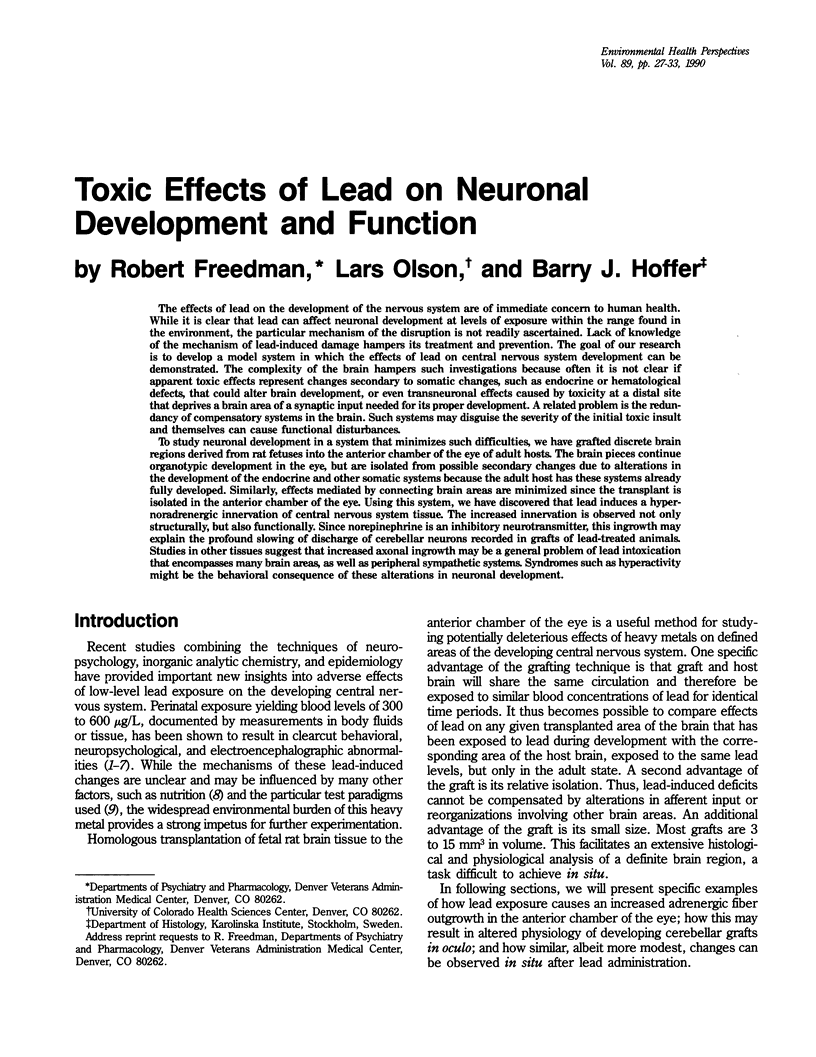
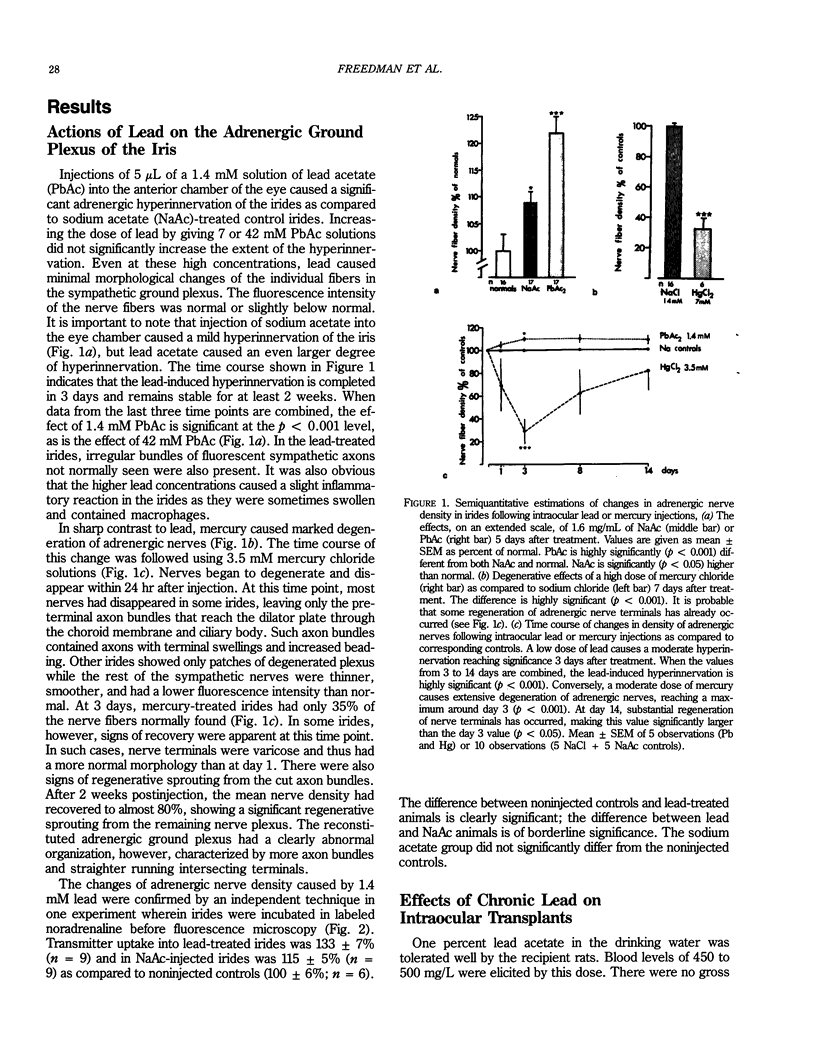
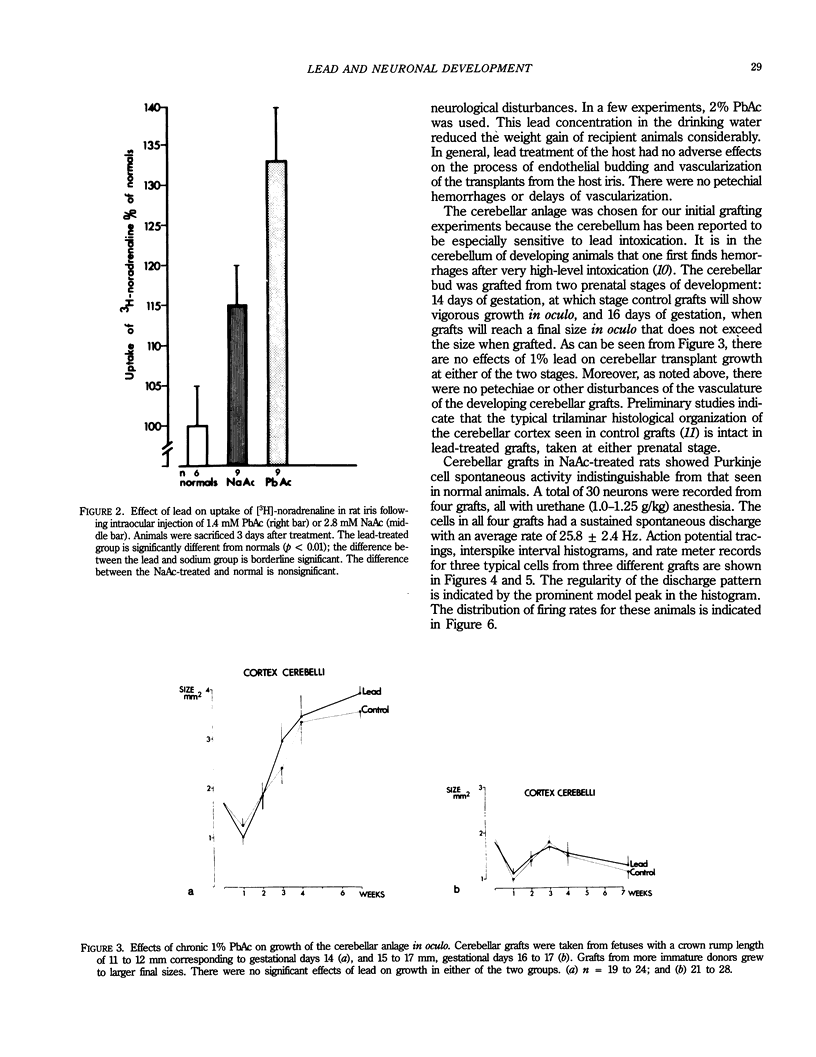
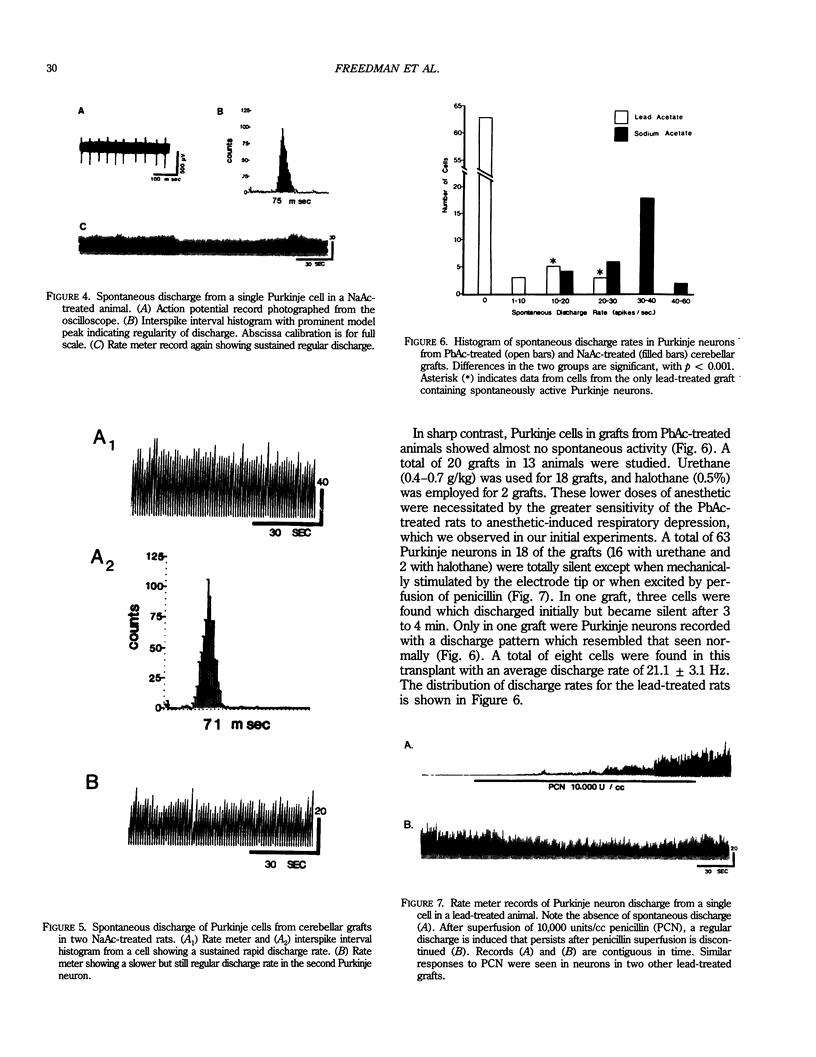
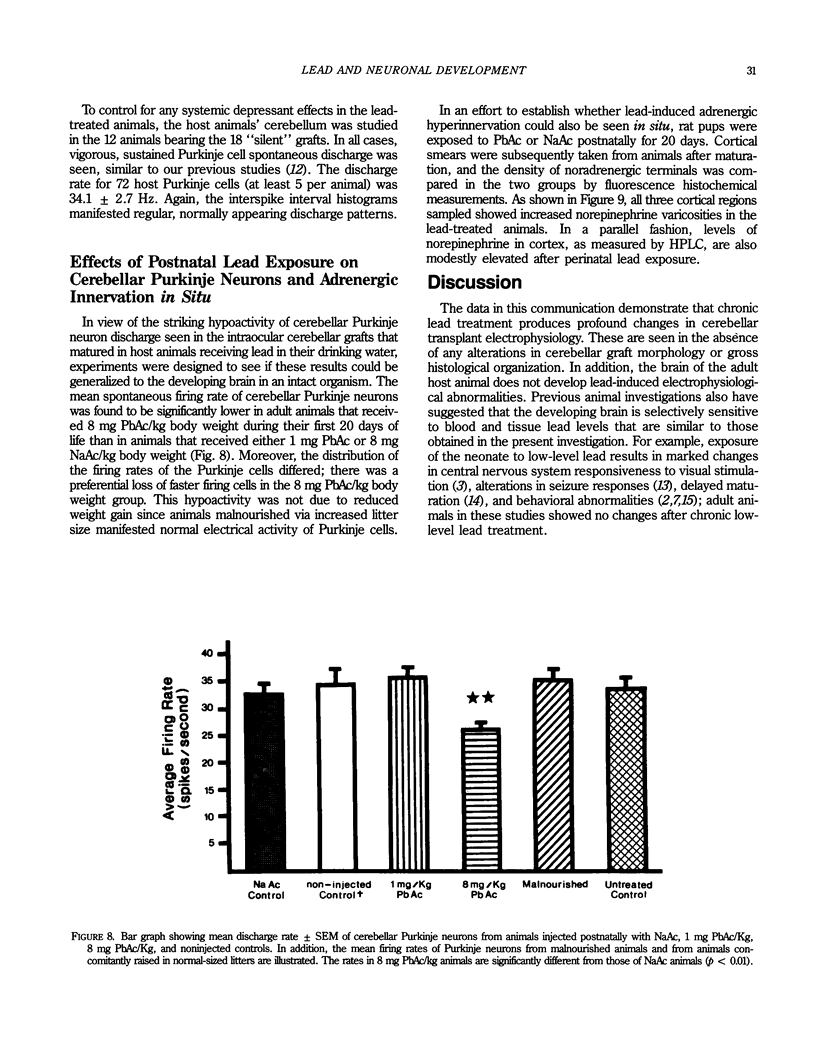
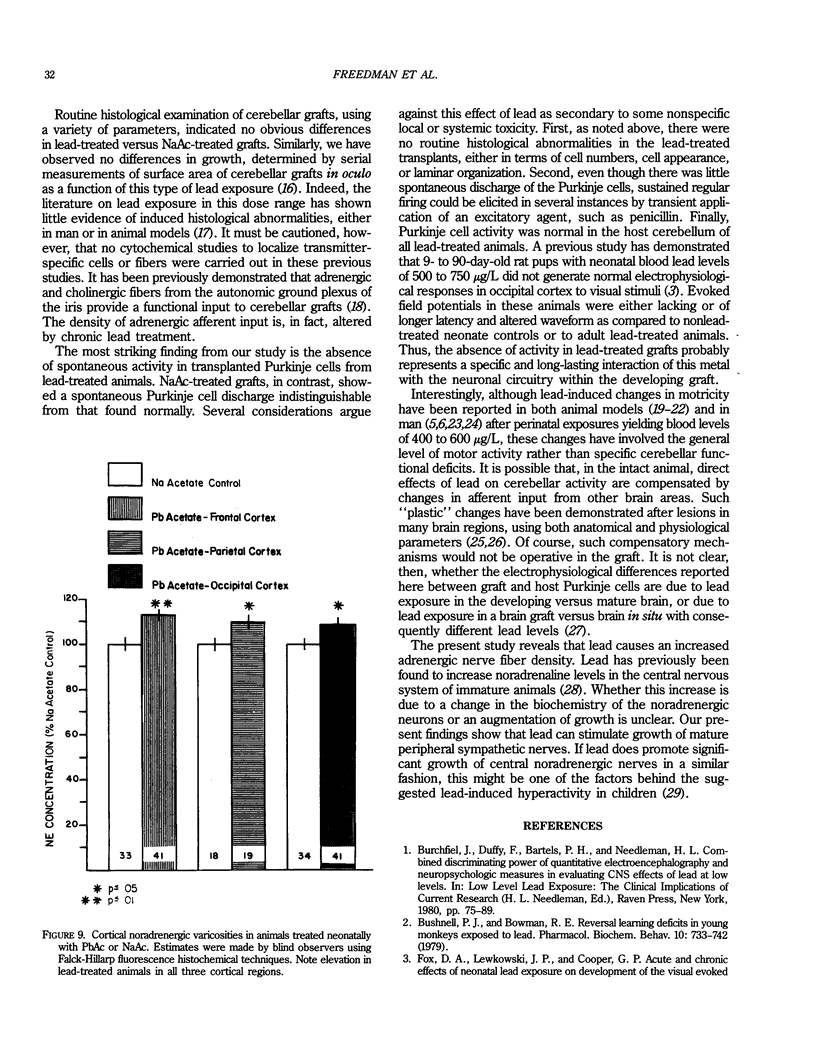
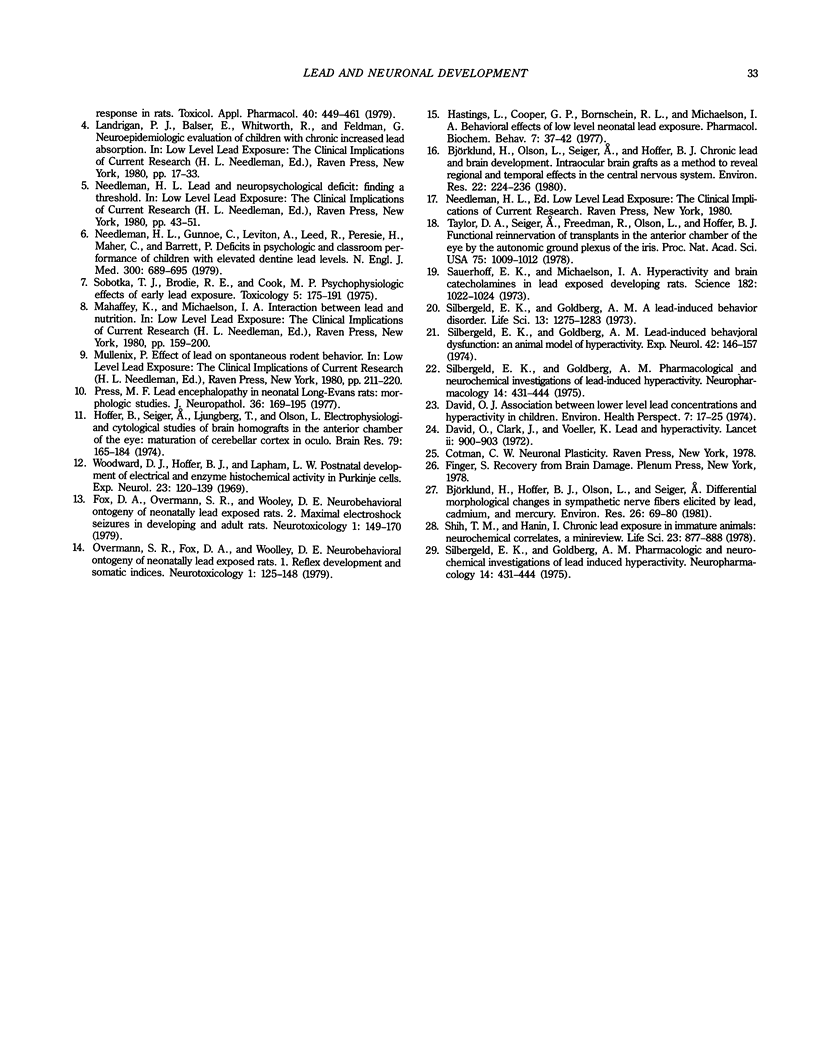
Selected References
These references are in PubMed. This may not be the complete list of references from this article.
- Björklund H., Hoffer B., Olson L., Seiger A. Differential morphological changes in sympathetic nerve fibers elicited by lead, cadmium, and mercury. Environ Res. 1981 Oct;26(1):69–80. doi: 10.1016/0013-9351(81)90184-5. [DOI] [PubMed] [Google Scholar]
- Björklund H., Olson L., Seiger A., Hoffer B. Chronic lead and brain development: intraocular brain grafts as a method to reveal regional and temporal effects in the central nervous system. Environ Res. 1980 Jun;22(1):224–236. doi: 10.1016/0013-9351(80)90134-6. [DOI] [PubMed] [Google Scholar]
- Bushnell P. J., Bowman R. E. Reversal learning deficits in young monkeys exposed to lead. Pharmacol Biochem Behav. 1979 May;10(5):733–742. doi: 10.1016/0091-3057(79)90326-5. [DOI] [PubMed] [Google Scholar]
- David O. J. Association between lower level lead concentrations and hyperactivity in children. Environ Health Perspect. 1974 May;7:17–25. doi: 10.1289/ehp.74717. [DOI] [PMC free article] [PubMed] [Google Scholar]
- Fox D. A., Lewkowski J. P., Cooper G. P. Acute and chronic effects of neonatal lead exposure on development of the visual evoked responses in rats. Toxicol Appl Pharmacol. 1977 Jun;40(3):449–461. doi: 10.1016/0041-008x(77)90072-2. [DOI] [PubMed] [Google Scholar]
- Hastings L., Cooper G. P., Bornschein R. L., Michaelson I. A. Behavioral effects of low level neonatal lead exposure. Pharmacol Biochem Behav. 1977 Jul;7(1):37–42. doi: 10.1016/0091-3057(77)90007-7. [DOI] [PubMed] [Google Scholar]
- Hoffer B., Seiger A., Ljungberg T., Olson L. Electrophysiological and cytological studies of brain homografts in the anterior chamber of the eye: maturation of cerebellar cortex in oculo. Brain Res. 1974 Oct 18;79(2):165–184. doi: 10.1016/0006-8993(74)90409-0. [DOI] [PubMed] [Google Scholar]
- Needleman H. L., Gunnoe C., Leviton A., Reed R., Peresie H., Maher C., Barrett P. Deficits in psychologic and classroom performance of children with elevated dentine lead levels. N Engl J Med. 1979 Mar 29;300(13):689–695. doi: 10.1056/NEJM197903293001301. [DOI] [PubMed] [Google Scholar]
- Press M. F. Lead encephalopathy in neonatal Long-Evans rats: morphologic studies. J Neuropathol Exp Neurol. 1977 Jan;36(1):169–193. doi: 10.1097/00005072-197701000-00014. [DOI] [PubMed] [Google Scholar]
- Sauerhoff M. W., Michaelson I. A. Hyperactivity and brain catecholamines in lead-exposed developing rats. Science. 1973 Dec 7;182(4116):1022–1024. doi: 10.1126/science.182.4116.1022. [DOI] [PubMed] [Google Scholar]
- Shih T. M., Hanin I. Chronic lead exposure in immature animals: neurochemical correlates. Life Sci. 1978 Sep 4;23(9):877–888. doi: 10.1016/0024-3205(78)90212-6. [DOI] [PubMed] [Google Scholar]
- Silbergeld E. K., Goldberg A. M. Lead-induced behavioral dysfunction: an animal model of hyperactivity. Exp Neurol. 1974 Jan;42(1):146–157. doi: 10.1016/0014-4886(74)90013-2. [DOI] [PubMed] [Google Scholar]
- Silbergeld E. K., Goldberg A. M. Pharmacological and neurochemical investigations of lead-induced hyperactivity. Neuropharmacology. 1975 May-Jun;14(5-6):431–444. doi: 10.1016/0028-3908(75)90026-x. [DOI] [PubMed] [Google Scholar]
- Silbergeld E. K., Goldberg A. M. Pharmacological and neurochemical investigations of lead-induced hyperactivity. Neuropharmacology. 1975 May-Jun;14(5-6):431–444. doi: 10.1016/0028-3908(75)90026-x. [DOI] [PubMed] [Google Scholar]
- Sobotka T. J., Brodie R. E., Cook M. P. Psychophysiologic effects of early lead exposure. Toxicology. 1975 Nov;5(2):175–191. doi: 10.1016/0300-483x(75)90115-8. [DOI] [PubMed] [Google Scholar]
- Taylor D., Seiger A., Freedman R., Olson L., Hoffer B. Electrophysiological analysis reinnervation of transplants in the anterior chamber of the eye by the autonomic ground plexus of the iris. Proc Natl Acad Sci U S A. 1978 Feb;75(2):1009–1012. doi: 10.1073/pnas.75.2.1009. [DOI] [PMC free article] [PubMed] [Google Scholar]
- Woodward D. J., Hoffer B. J., Lapham L. W. Postnatal development of electrical and enzyme histochemical activity in Purkinje cells. Exp Neurol. 1969 Jan;23(1):120–139. doi: 10.1016/0014-4886(69)90039-9. [DOI] [PubMed] [Google Scholar]


